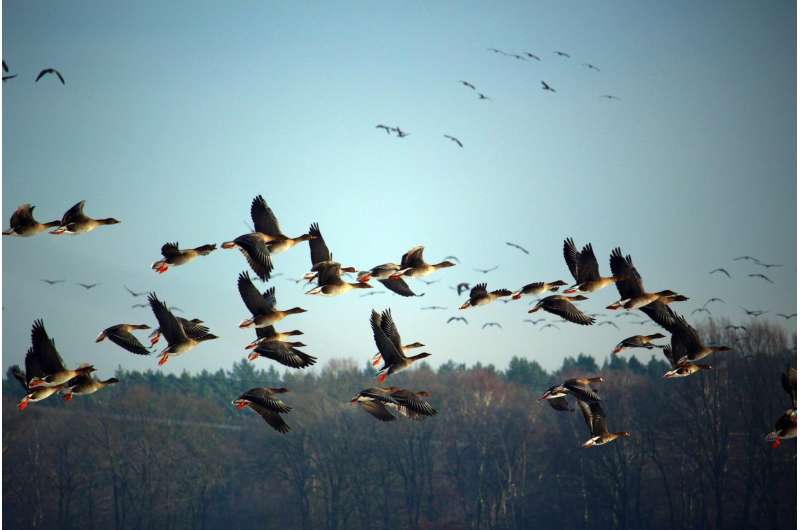More than 4 billion birds stream overhead during fall migration

Using cloud computing and data from 143 weather radar stations across the continental United States, Cornell Lab of Ornithology researchers can now estimate how many birds migrate through the U.S. and the toll that winter and these nocturnal journeys take. Their findings are published in Nature Ecology & Evolution.
"We've discovered that each autumn, an average of 4 billion birds move south from Canada into the U.S. At the same time, another 4.7 billion birds leave the U.S. over the southern border, heading to the tropics," notes lead author Adriaan Dokter, an Edward W. Rose postdoctoral fellow at the Cornell Lab. "In the spring, 3.5 billion birds cross back into the U.S. from points south, and 2.6 billion birds return to Canada across the northern U.S. border."
In other words, fewer birds return to their breeding grounds after going through fall migration and spending months on their wintering grounds. But the researchers were surprised to find that the migrants arriving across the U.S. southern border had an average return rate of 76 percent during the 5 years of the study (2013 to 2017) and the birds wintering in the U.S. had only an average return rate of 64 percent.
"Contrary to popular thought, birds wintering in the tropics survive the winter better than birds wintering in the U.S.," says Andrew Farnsworth, co-author of the study and leader of the Cornell Lab's aeroecology program. "That's despite the fact that tropical wintering birds migrate three to four times farther than the birds staying in the U.S."
To reach these numbers, the researchers developed complicated algorithms to measure differences in biomass picked up by weather radar—in this case, the total mass of organisms in a given area, minus insects and weather. Migrants crossing the northern border—such as many sparrows, American Robins, and Dark-eyed Juncos—have shorter migrations from breeding grounds in Canada to wintering grounds in the U.S.
Measurements from the southern border captured data on migrants that breed in the U.S. and spend their winters in places such as Central or South America, such as most warblers, orioles, and tanagers. One explanation for the higher mortality among birds wintering in the U.S. may be the number of hazards they face.
"All birds need suitable habitats with enough resources to get them through the winter," notes Ken Rosenberg, co-author and conservation scientist at the Cornell Lab. "Birds wintering in the U.S. may have more habitat disturbances and more buildings to crash into, and they might not be adapted for that."
Another reason for the disparity in migration return rates between short and long-distance migrants may have to do with breeding strategy. Birds wintering in the U.S. have high reproduction rates to offset higher mortality. Tropical wintering species have fewer offspring, but more adults survive through the winter and reproduce the following spring, despite their longer migrations. But it's a strategy that may backfire without conservation efforts in the tropics.
"Longer distance migrants seem to be gambling on having high survival in the tropics, and they're therefore more sensitive to what happens to their wintering grounds," says Dokter. "Even a small decrease in survival due to changes in their tropical habitats might cause a precipitous decline."
More information: Adriaan M. Dokter et al, Seasonal abundance and survival of North America's migratory avifauna determined by weather radar, Nature Ecology & Evolution (2018). DOI: 10.1038/s41559-018-0666-4
Journal information: Nature Ecology & Evolution
Provided by Cornell University




















